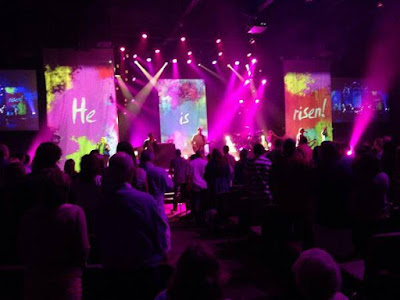My concept on this design was pretty simple. I wanted to create a modern twist on the old school Baptist Church house light. Growing up in Southern Illinois pretty much every Baptist church had these acrylic cylinders to diffuse their houselights.
Acquiring the tubes: A good friend of mine, Jason at JRLX, were talking about projects and he mentioned a church up near Chicago that was about to upgrade their houselights. They were planning on throwing them out, so we offered the church $200 for them and arranged shipping to Oklahoma. There are probably better ways to find / acquire these that are closer, but it was a good opportunity that we didn't want to pass up. I have since seen these multiple times on craigslist and places like Habitat for Humanity Restore.
To light the tubes, we used GLP Pixel tape that we zip tied to the back side of the side of the tubes. We used 2 rows to make it as bright as possible. In order to do this we drilled 3 holes 1" apart at the top and bottom of the tube. We used these holes to zip tie and attach the led tape.
We also drilled holes on the back side of the tubes that we used to attach the power supplies and decoders to. We wanted everything for the tube to be self contained so that in future sets we could randomly place them without having to figure out anything more than standard DMX and power. You can see a photo of how we mounted and wired the power supply and decoders below.
As you can see from the below layout, we decided to put a 101 above each lantern. This ended up working great as if we needed additional punch, we could shoot the 101 directly into the lantern.
Behind the lanterns we used the always amazing crushed aluminum screening. Another small detail that made a large difference in our room and on video was the addition of some drape lighting on the wings of the stage. The area behind our side screens was normally pretty dark, but with the addition of a few LED pars we added a touch of color that helped get rid of black holes in our side shots.
Another cool element, was that we used the Aluminum window screen backdrop like a scrim. Behind the aluminum screen backdrop we had pixel tape spaced about 2' apart that ran vertically. This tape acted as a low res LED wall. You can see in the photos below how the feel changed by dimming out the LED up lights on the Aluminum window screen and bringing in the LED content on the pixel tape.
Another cool element, was that we used the Aluminum window screen backdrop like a scrim. Behind the aluminum screen backdrop we had pixel tape spaced about 2' apart that ran vertically. This tape acted as a low res LED wall. You can see in the photos below how the feel changed by dimming out the LED up lights on the Aluminum window screen and bringing in the LED content on the pixel tape.
You can see some video of this design at our Easter services here.
Lastly, This design helped shape and inspire another product we designed for Mod Scenes. Our DMX Pixel hoists. You can see some photos and videos of those below.



















